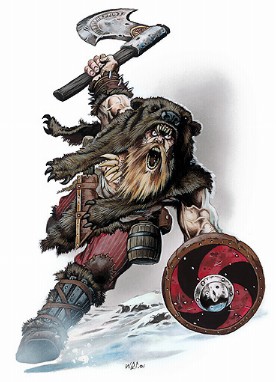The berserker of the Vikings and the ancient Germans was a man who believed that he could transform himself into a bear or a wolf when the need arose.

They dressed in bear or wolf skins, and sometimes wore bear claws. Berserkers would attain a mental-shamanistic balance of beast and with a mind sigil of Odin and Wotan ascend to the battle like enraged beasts and fight until death.
They threw down their swords and bit their enemies with their teeth. They were insensible to pain and knew no fear.
A recent study suggests that they were able to achieve their battle trances and ferocity through the use of henbane. Previous studies suggest that Amanita muscaria, a mushroom commonly called fly agaric, was used by the Norse to become berserkers.
Apparently the berserker rage was under control, most of the time, but ordinary people lived in terror of such savage warriors since they never knew what small incident might trigger the fury.
The rage of the berserker was passed down in an hereditary line from father to son — it does not appear to have afflicted women.
Werewolves of this culture had titles as Sinfjotle (he with yellow paws), Hjarulv (sword wolf) and Kveldulf (evening wolf). It may have been a genetic disorder, but more likely it was a manifestation of shamanism, the knowledge of which was also passed down within families — the berserker was very likely a form of shape-shifter.
There was supposed to exist three different packs or types of Berserk: the svinfylkingars or boar warriors, the ulfhednars / ulfarks or wolf warriors and the berserkers or bear warriors.
